Climate Change and Renewable Energy Generation in Europe—Long-Term Impact Assessment on Solar and Wind Energy Using High-Resolution Future Climate Data and Considering Climate Uncertainties
Abstract
:1. Introduction
2. Materials and Methods
2.1. Climate Data
2.2. Wind and Solar Power
2.3. Spearman’s Rank Correlation Coefficient
3. Results and Discussion
3.1. Long-Term Trends of Solar and Wind Energy Potential
3.2. Long-Term Variations Due to Climate Change and Uncertainties
3.3. Seasonal PV and Wind Energy Potential and Their Variations
3.4. Spearman’s Correlation Analysis
4. Conclusions
Author Contributions
Funding
Institutional Review Board Statement
Informed Consent Statement
Data Availability Statement
Conflicts of Interest
References
- Sadik-Zada, E.R.; Gatto, A. Energy Security Pathways in South East Europe: Diversification of the Natural Gas Supplies, Energy Transition, and Energy Futures. In From Economic to Energy Transition: Three Decades of Transitions in Central and Eastern Europe; Mišík, M., Oravcová, V., Eds.; Energy, Climate and the Environment; Springer International Publishing: Cham, Switzerland, 2021; pp. 491–514. ISBN 978-3-030-55085-1. [Google Scholar]
- Edenhofer, O. (Ed.) Climate Change 2014: Mitigation of Climate Change: Working Group III Contribution to the Fifth Assessment Report of the Intergovernmental Panel on Climate Change; Intergovernmental Panel on Climate Change; Cambridge University Press: New York, NY, USA, 2014; ISBN 978-1-107-05821-7. [Google Scholar]
- Renewable Energy Statistics—Statistics Explained. Available online: https://ec.europa.eu/eurostat/statistics-explained/index.php/Renewable_energy_statistics#Share_of_renewable_energy_almost_doubled_between_2004_and_2018 (accessed on 1 February 2021).
- Solar PV—Renewables 2020—Analysis—IEA. Available online: https://www.iea.org/reports/renewables-2020/solar-pv (accessed on 21 February 2021).
- UN. Paris Agreement; 6 United Nations Framework Convention on Climate Change (UNFCCC): Paris, France, 2016; Volume 55. [Google Scholar]
- EU Power Sector in 2020. Available online: https://static.agora-energiewende.de/fileadmin/Projekte/2021/2020_01_EU-Annual-Review_2020/A-EW_202_Report_European-Power-Sector-2020.pdf (accessed on 27 December 2021).
- Anonymous. 2030 Climate & Energy Framework. Available online: https://ec.europa.eu/clima/policies/strategies/2030_en (accessed on 25 February 2021).
- Brodny, J.; Tutak, M.; Bindzár, P. Assessing the Level of Renewable Energy Development in the European Union Member States. A 10-Year Perspective. Energies 2021, 14, 3765. [Google Scholar] [CrossRef]
- Perera, A.T.D.; Javanroodi, K.; Wang, Y.; Hong, T. Urban Cells: Extending the Energy Hub Concept to Facilitate Sector and Spatial Coupling. Adv. Appl. Energy 2021, 3, 100046. [Google Scholar] [CrossRef]
- Sadik-Zada, E.R. Political Economy of Green Hydrogen Rollout: A Global Perspective. Sustainability 2021, 13, 13464. [Google Scholar] [CrossRef]
- Actions Being Taken by the EU. Available online: https://ec.europa.eu/info/strategy/priorities-2019-2024/european-green-deal/actions-being-taken-eu_en (accessed on 1 February 2021).
- Alberini, A.; Prettico, G.; Shen, C.; Torriti, J. Hot Weather and Residential Hourly Electricity Demand in Italy. Energy 2019, 177, 44–56. [Google Scholar] [CrossRef]
- Silva, S.; Soares, I.; Pinho, C. Climate Change Impacts on Electricity Demand: The Case of a Southern European Country. Util. Policy 2020, 67, 101115. [Google Scholar] [CrossRef]
- Bloomfield, H.C.; Brayshaw, D.J.; Troccoli, A.; Goodess, C.M.; De Felice, M.; Dubus, L.; Bett, P.E.; Saint-Drenan, Y.-M. Quantifying the Sensitivity of European Power Systems to Energy Scenarios and Climate Change Projections. Renew. Energy 2021, 164, 1062–1075. [Google Scholar] [CrossRef]
- Pachauri, R.K.; Meyer, L.; Hallegatte France, S.; Bank, W.; Hegerl, G.; Brinkman, S.; van Kesteren, L.; Leprince-Ringuet, N.; van Boxmeer, F. IPCC Climate Change 2014: Synthesis Report; Gian-Kasper Plattner: Geneva, Switzerland, 2014; ISBN 978-92-9169-143-2. [Google Scholar]
- Chen, L. Uncertainties in Solar Radiation Assessment in the United States Using Climate Models. Clim. Dyn. 2021, 56, 665–678. [Google Scholar] [CrossRef]
- Fant, C.; Adam Schlosser, C.; Strzepek, K. The Impact of Climate Change on Wind and Solar Resources in Southern Africa. Appl. Energy 2016, 161, 556–564. [Google Scholar] [CrossRef] [Green Version]
- Huang, G.; Li, Z.; Li, X.; Liang, S.; Yang, K.; Wang, D.; Zhang, Y. Estimating Surface Solar Irradiance from Satellites: Past, Present, and Future Perspectives. Remote Sens. Environ. 2019, 233, 111371. [Google Scholar] [CrossRef]
- Randall, D.A.; Wood, R.A.; Bony, S.; Colman, R.; Fichefet, T.; Fyfe, J.; Kattsov, V.; Pitman, A.; Shukla, J.; Srinivasan, J.; et al. Climate Models and Their Evaluation; Cambridge University Press: Cambridge, UK, 2007; p. 74. [Google Scholar]
- Viviescas, C.; Lima, L.; Diuana, F.A.; Vasquez, E.; Ludovique, C.; Silva, G.N.; Huback, V.; Magalar, L.; Szklo, A.; Lucena, A.F.P.; et al. Contribution of Variable Renewable Energy to Increase Energy Security in Latin America: Complementarity and Climate Change Impacts on Wind and Solar Resources. Renew. Sustain. Energy Rev. 2019, 113, 109232. [Google Scholar] [CrossRef]
- Oka, K.; Mizutani, W.; Ashina, S. Climate Change Impacts on Potential Solar Energy Production: A Study Case in Fukushima, Japan. Renew. Energy 2020, 153, 249–260. [Google Scholar] [CrossRef]
- Pryor, S.C.; Schoof, J.T.; Barthelmie, R.J. Winds of Change? Projections of near-Surface Winds under Climate Change Scenarios. Geophys. Res. Lett. 2006, 33, L11702. [Google Scholar] [CrossRef] [Green Version]
- Yang, Y.; Javanroodi, K.; Nik, V.M. Climate Change and Energy Performance of European Residential Building Stocks—A Comprehensive Impact Assessment Using Climate Big Data from the Coordinated Regional Climate Downscaling Experiment. Appl. Energy 2021, 298, 117246. [Google Scholar] [CrossRef]
- Perera, A.T.D.; Nik, V.M.; Chen, D.; Scartezzini, J.L.; Hong, T. Quantifying the Impacts of Climate Change and Extreme Climate Events on Energy Systems. Nat. Energy 2020, 5, 150–159. [Google Scholar] [CrossRef] [Green Version]
- Yang, Y.; Javanroodi, K.; Nik, V.M. Impact Assessment of Climate Change on the Energy Performance of the Building Stocks in Four European Cities. E3S Web Conf. 2020, 172, 02008. [Google Scholar] [CrossRef]
- Perera, A.T.D.; Javanroodi, K.; Nik, V.M. Climate Resilient Interconnected Infrastructure: Co-Optimization of Energy Systems and Urban Morphology. Appl. Energy 2021, 285, 116430. [Google Scholar] [CrossRef]
- Weber, J.; Gotzens, F.; Witthaut, D. Impact of Strong Climate Change on the Statistics of Wind Power Generation in Europe. Energy Procedia 2018, 153, 22–28. [Google Scholar] [CrossRef]
- Moemken, J.; Reyers, M.; Feldmann, H.; Pinto, J.G. Future Changes of Wind Speed and Wind Energy Potentials in EURO-CORDEX Ensemble Simulations. J. Geophys. Res. Atmos. 2018, 123, 6373–6389. [Google Scholar] [CrossRef]
- Reyers, M.; Moemken, J.; Pinto, J.G. Future Changes of Wind Energy Potentials over Europe in a Large CMIP5 Multi-Model Ensemble. Int. J. Climatol. 2016, 36, 783–796. [Google Scholar] [CrossRef]
- Tobin, I.; Jerez, S.; Vautard, R.; Thais, F.; van Meijgaard, E.; Prein, A.; Déqué, M.; Kotlarski, S.; Maule, C.F.; Nikulin, G.; et al. Climate Change Impacts on the Power Generation Potential of a European Mid-Century Wind Farms Scenario. Environ. Res. Lett. 2016, 11, 034013. [Google Scholar] [CrossRef]
- Jerez, S.; Tobin, I.; Vautard, R.; Montávez, J.P.; López-Romero, J.M.; Thais, F.; Bartok, B.; Christensen, O.B.; Colette, A.; Déqué, M.; et al. The Impact of Climate Change on Photovoltaic Power Generation in Europe. Nat. Commun. 2015, 6, 10014. [Google Scholar] [CrossRef] [Green Version]
- Wild, M.; Folini, D.; Henschel, F.; Fischer, N.; Müller, B. Projections of Long-Term Changes in Solar Radiation Based on CMIP5 Climate Models and Their Influence on Energy Yields of Photovoltaic Systems. Sol. Energy 2015, 116, 12–24. [Google Scholar] [CrossRef] [Green Version]
- Panagea, I.S.; Tsanis, I.K.; Koutroulis, A.G.; Grillakis, M.G. Climate Change Impact on Photovoltaic Energy Output: The Case of Greece. Available online: https://www.hindawi.com/journals/amete/2014/264506/ (accessed on 1 March 2021).
- Müller, J.; Folini, D.; Wild, M.; Pfenninger, S. CMIP-5 Models Project Photovoltaics Are a No-Regrets Investment in Europe Irrespective of Climate Change. Energy 2019, 171, 135–148. [Google Scholar] [CrossRef]
- Nik, V.M. Making Energy Simulation Easier for Future Climate—Synthesizing Typical and Extreme Weather Data Sets out of Regional Climate Models (RCMs). Appl. Energy 2016, 177, 204–226. [Google Scholar] [CrossRef]
- Riahi, K.; van Vuuren, D.P.; Kriegler, E.; Edmonds, J.; O’Neill, B.C.; Fujimori, S.; Bauer, N.; Calvin, K.; Dellink, R.; Fricko, O.; et al. The Shared Socioeconomic Pathways and Their Energy, Land Use, and Greenhouse Gas Emissions Implications: An Overview. Glob. Environ. Chang. 2017, 42, 153–168. [Google Scholar] [CrossRef] [Green Version]
- van Vuuren, D.P.; Riahi, K.; Moss, R.; Edmonds, J.; Thomson, A.; Nakicenovic, N.; Kram, T.; Berkhout, F.; Swart, R.; Janetos, A.; et al. A Proposal for a New Scenario Framework to Support Research and Assessment in Different Climate Research Communities. Glob. Environ. Chang. 2012, 22, 21–35. [Google Scholar] [CrossRef] [Green Version]
- Vad Är RCP? | SMHI. Available online: https://www.smhi.se/klimat/framtidens-klimat/vagledning-klimatscenarier/vad-ar-rcp-1.80271 (accessed on 30 November 2020).
- Navarro-Racines, C.; Tarapues, J.; Thornton, P.; Jarvis, A.; Ramirez-Villegas, J. High-Resolution and Bias-Corrected CMIP5 Projections for Climate Change Impact Assessments. Sci. Data 2020, 7, 7. [Google Scholar] [CrossRef] [PubMed] [Green Version]
- Moussavi Nik, V. Climate Simulation of an Attic Using Future Weather Data Sets-Statistical Methods for Data Processing and Analysis; Chalmers Tekniska Hogskola: Göteborg, Sweden, 2010. [Google Scholar]
- Pernigotto, G.; Gasparella, A. Classification of European Climates for Building Energy Simulation Analyses. In Proceedings of the 5th International High Performance Buildings Conference at Purdue, West Lafayette, IN, USA, 9–12 July 2018; p. 12. [Google Scholar]
- Moussavi Nik, V. Hygrothermal Simulations of Buildings Concerning Uncertainties of the Future Climate; Chalmers Tekniska Hogskola: Göteborg, Sweden, 2012; ISBN 978-91-7385-689-8. [Google Scholar]
- Walter, A.; Keuler, K.; Jacob, D.; Knoche, R.; Block, A.; Kotlarski, S.; Müller-Westermeier, G.; Rechid, D.; Ahrens, W. A High Resolution Reference Data Set of German Wind Velocity 1951–2001 and Comparison with Regional Climate Model Results. Meteorol. Z. 2006, 15, 585–596. [Google Scholar] [CrossRef]
- Hollweg, H.-D.; Böhm, U.; Fast, I.; Hennemuth, B.; Keuler, K.; Keup-Thiel, E.; Lautenschlager, M.; Ke, S.; Radtke, K.; Rockel, B.; et al. Ensemble Simulations over Europe with the Regional Climate Model CLM Forced with IPCC AR4 Global Scenarios; Max-Planck-Institut für Meteorologie Gruppe Modelle & Daten: Hamburg, Germany, 2008. [Google Scholar]
- Sailor, D.J.; Smith, M.; Hart, M. Climate Change Implications for Wind Power Resources in the Northwest United States. Renew. Energy 2008, 33, 2393–2406. [Google Scholar] [CrossRef]
- Đurišić, Ž.; Mikulović, J. Assessment of the Wind Energy Resource in the South Banat Region, Serbia. Renew. Sustain. Energy Rev. 2012, 16, 3014–3023. [Google Scholar] [CrossRef]
- Bañuelos-Ruedas, F.; Angeles-Camacho, C.; Rios-Marcuello, S. Analysis and Validation of the Methodology Used in the Extrapolation of Wind Speed Data at Different Heights. Renew. Sustain. Energy Rev. 2010, 14, 2383–2391. [Google Scholar] [CrossRef]
- Syed, A.H.; Javed, A.; Asim Feroz, R.M.; Calhoun, R. Partial Repowering Analysis of a Wind Farm by Turbine Hub Height Variation to Mitigate Neighboring Wind Farm Wake Interference Using Mesoscale Simulations. Appl. Energy 2020, 268, 115050. [Google Scholar] [CrossRef]
- Betz’ Law. Available online: http://xn--drmstrre-64ad.dk/wp-content/wind/miller/windpower%20web/en/tour/wres/betz.htm (accessed on 4 March 2021).
- Potić, I.; Joksimović, T.; Milinčić, U.; Kićović, D.; Milinčić, M. Wind Energy Potential for the Electricity Production—Knjaževac Municipality Case Study (Serbia). Energy Strategy Rev. 2021, 33, 100589. [Google Scholar] [CrossRef]
- How to Calculate Power Output of Wind. Available online: https://www.windpowerengineering.com/calculate-wind-power-output/ (accessed on 4 March 2021).
- Zervas, P.L.; Sarimveis, H.; Palyvos, J.A.; Markatos, N.C.G. Model-Based Optimal Control of a Hybrid Power Generation System Consisting of Photovoltaic Arrays and Fuel Cells. J. Power Sources 2008, 181, 327–338. [Google Scholar] [CrossRef]
- Siegel, S.; Castellan, N.J. Nonparametric Statistics for the Behavioral Sciences; McGraw-Hill: New York, NY, USA, 1988; ISBN 978-0-07-057357-4. [Google Scholar]
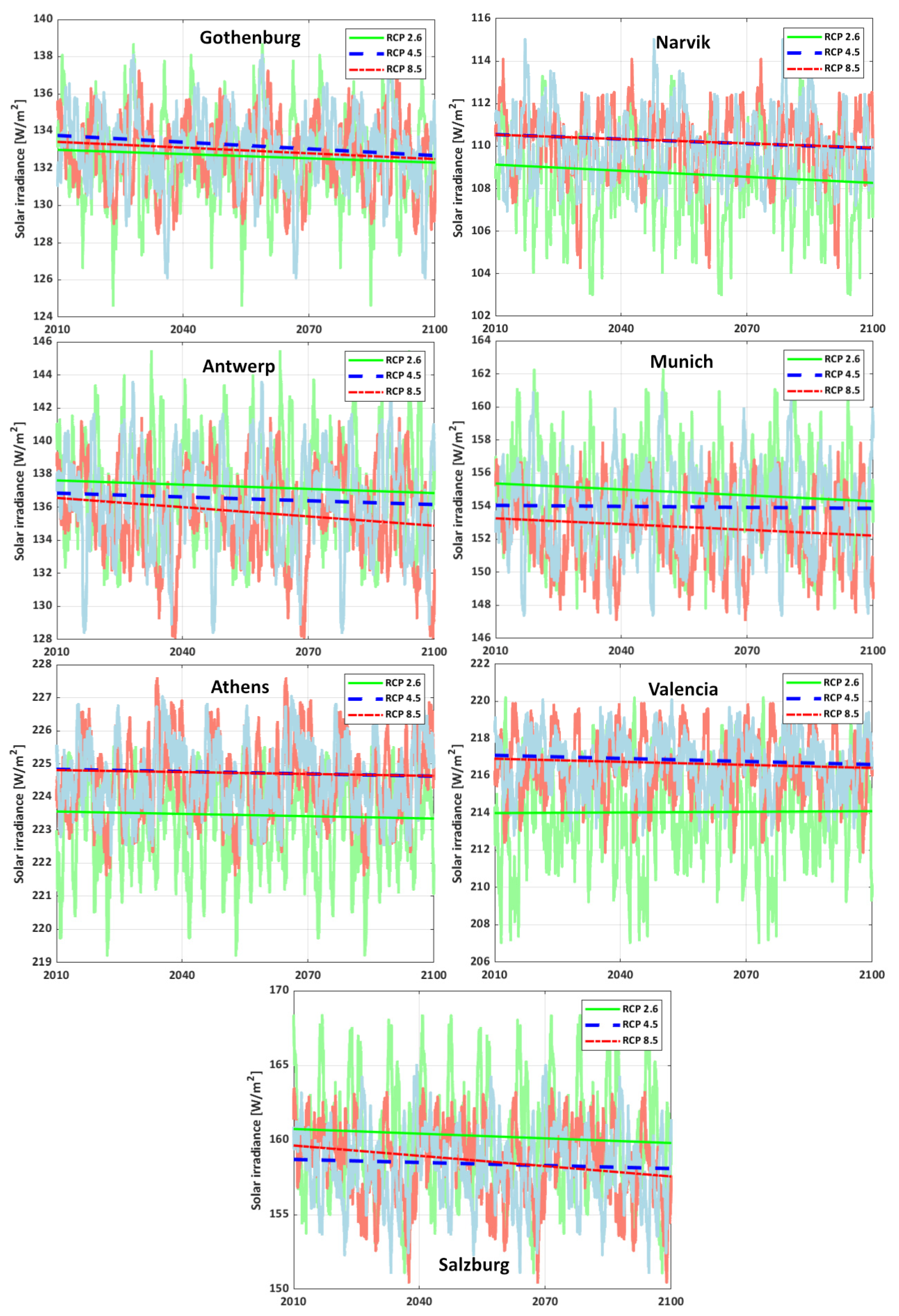

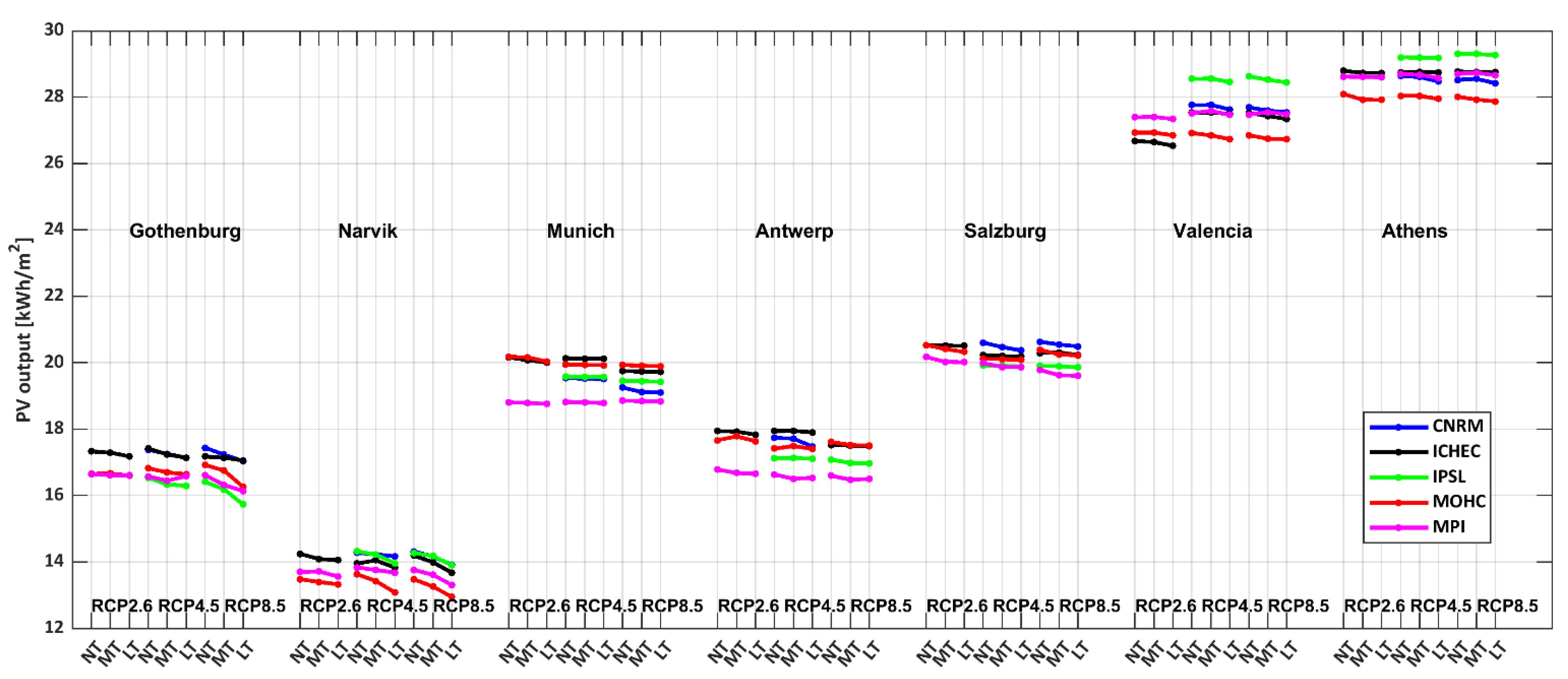
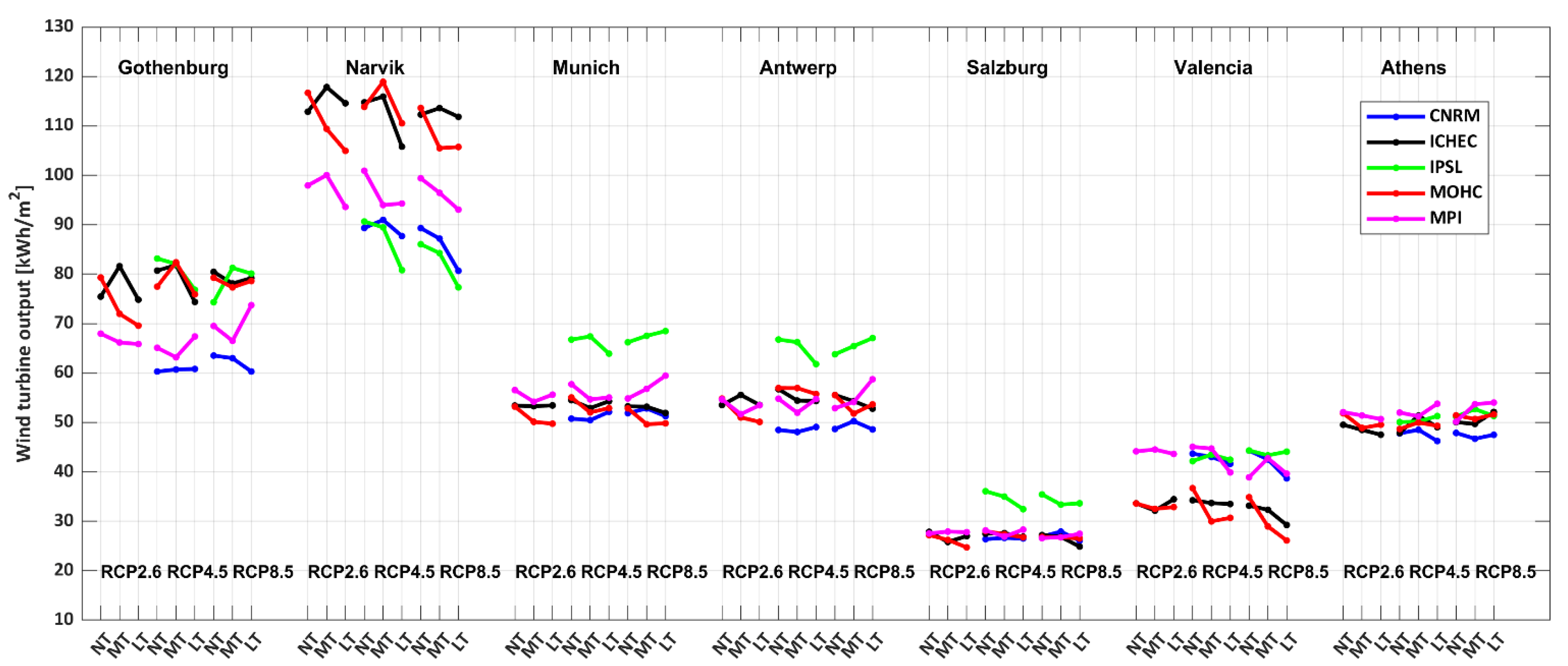
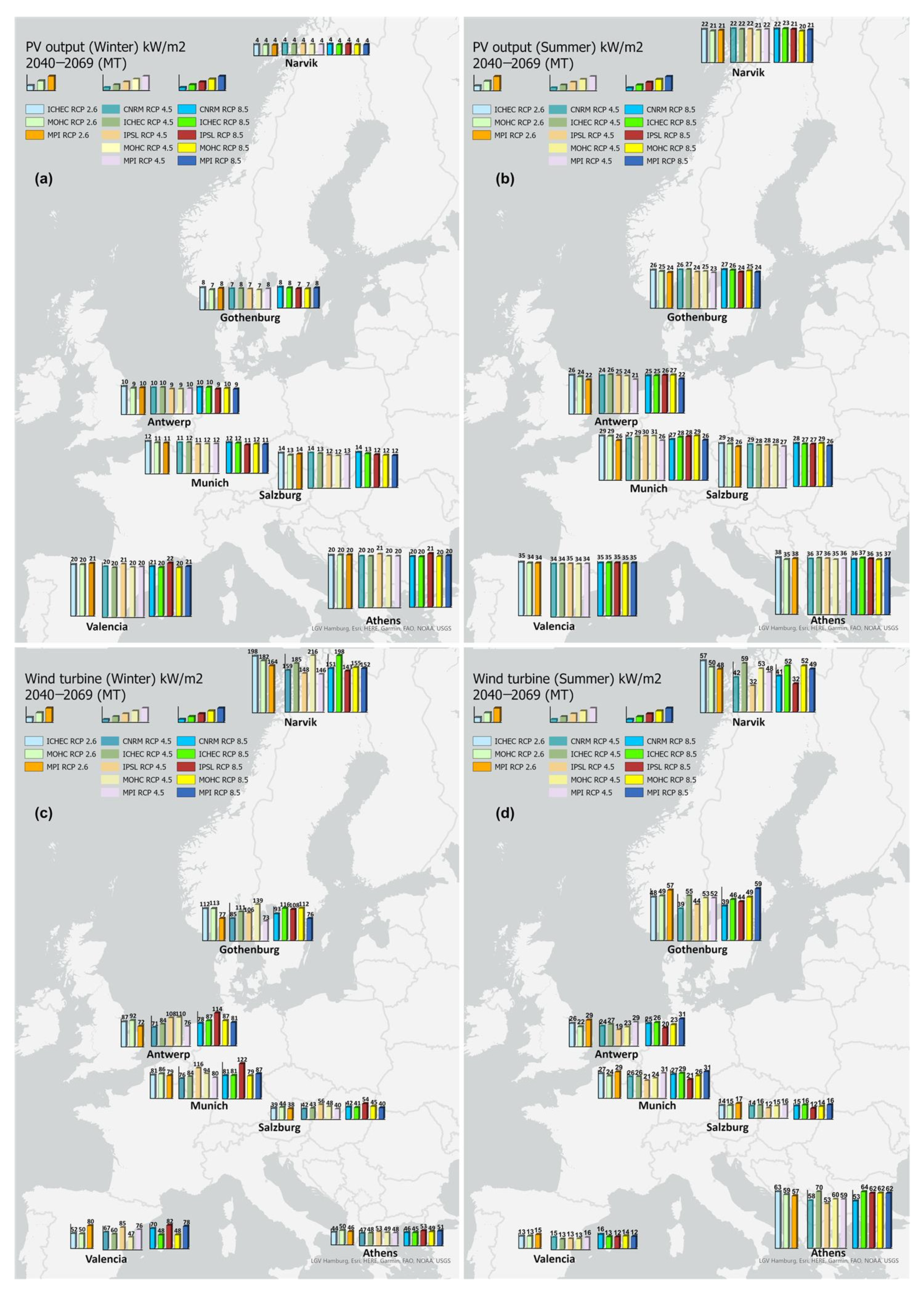

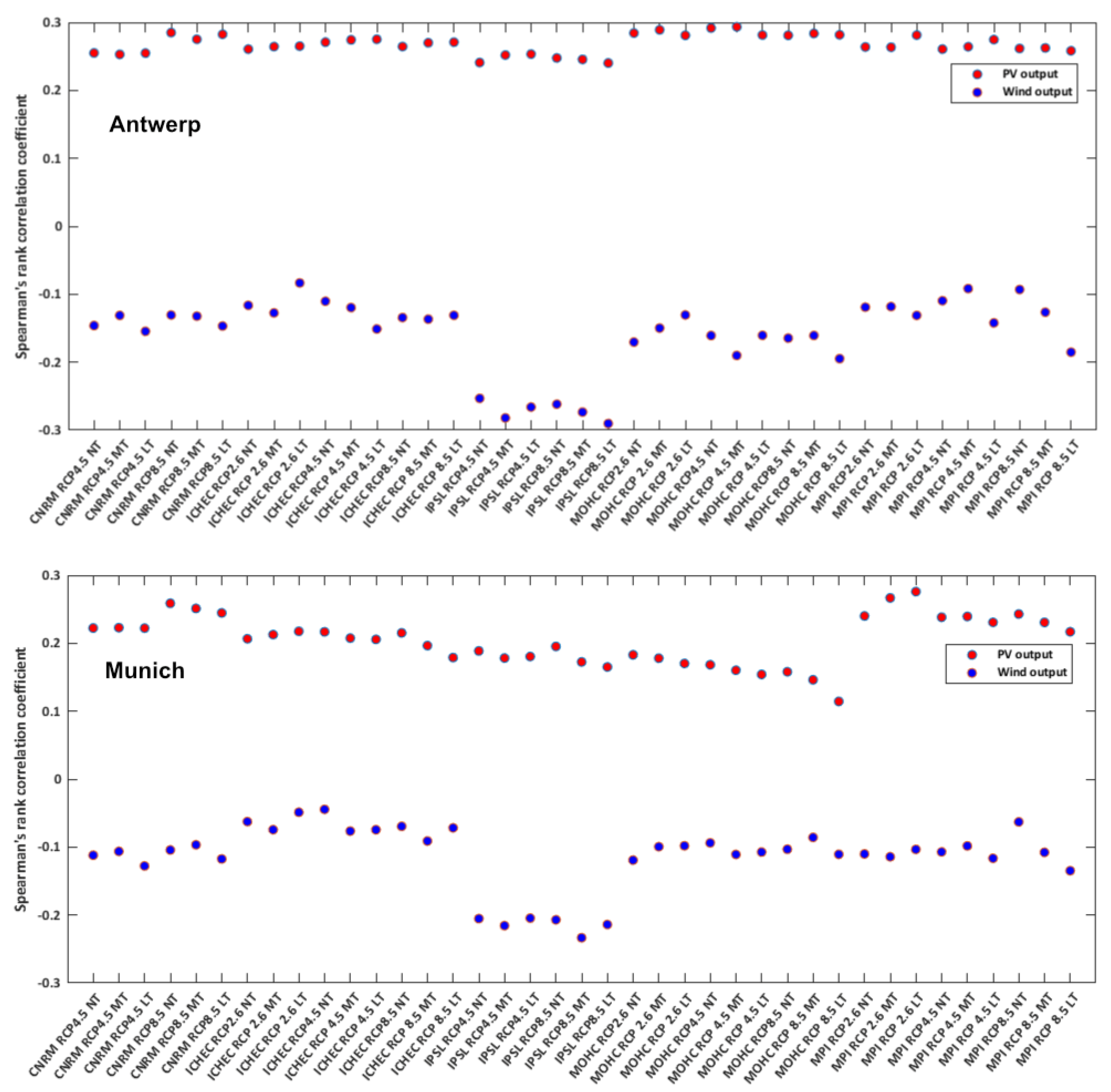
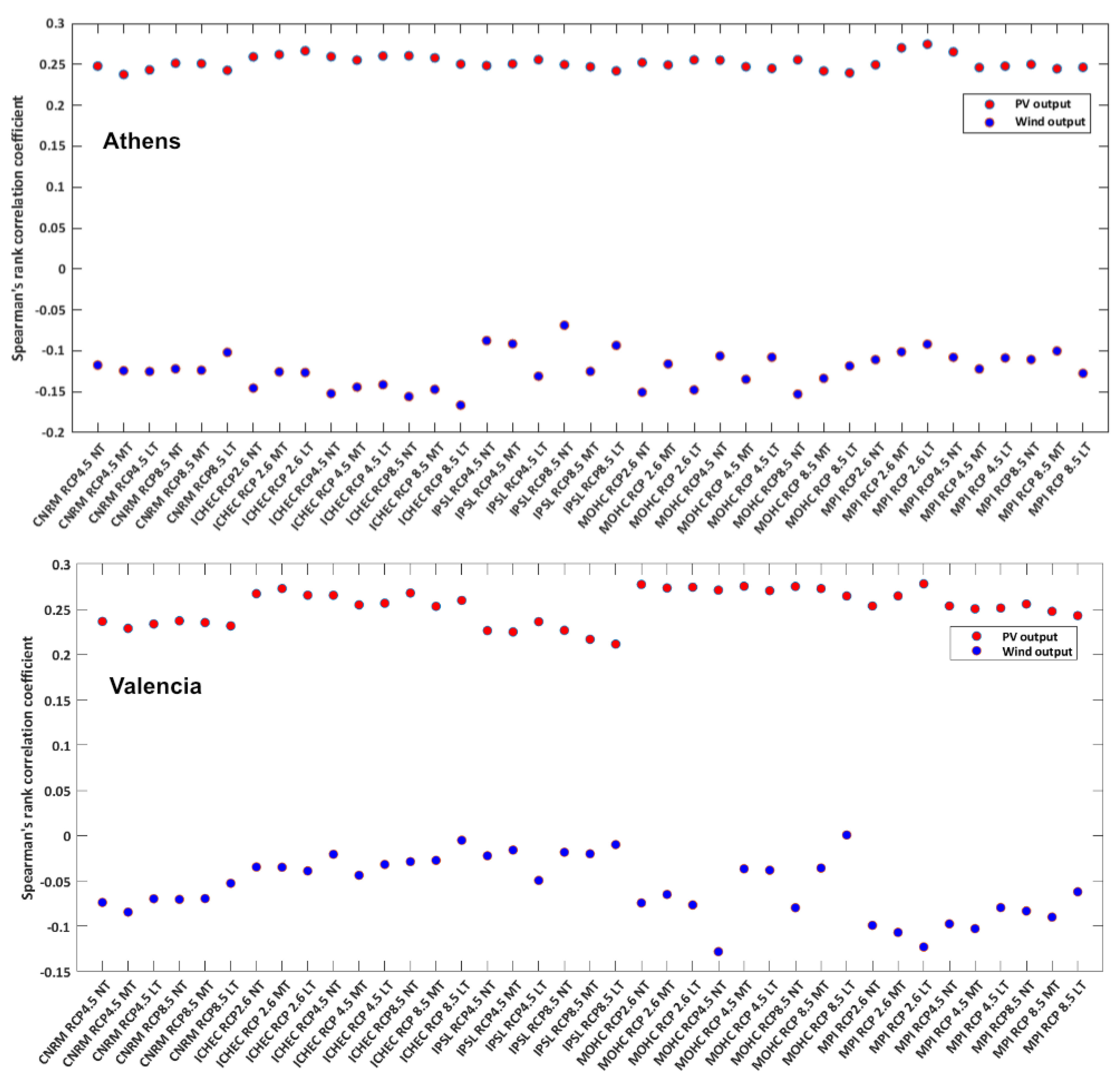
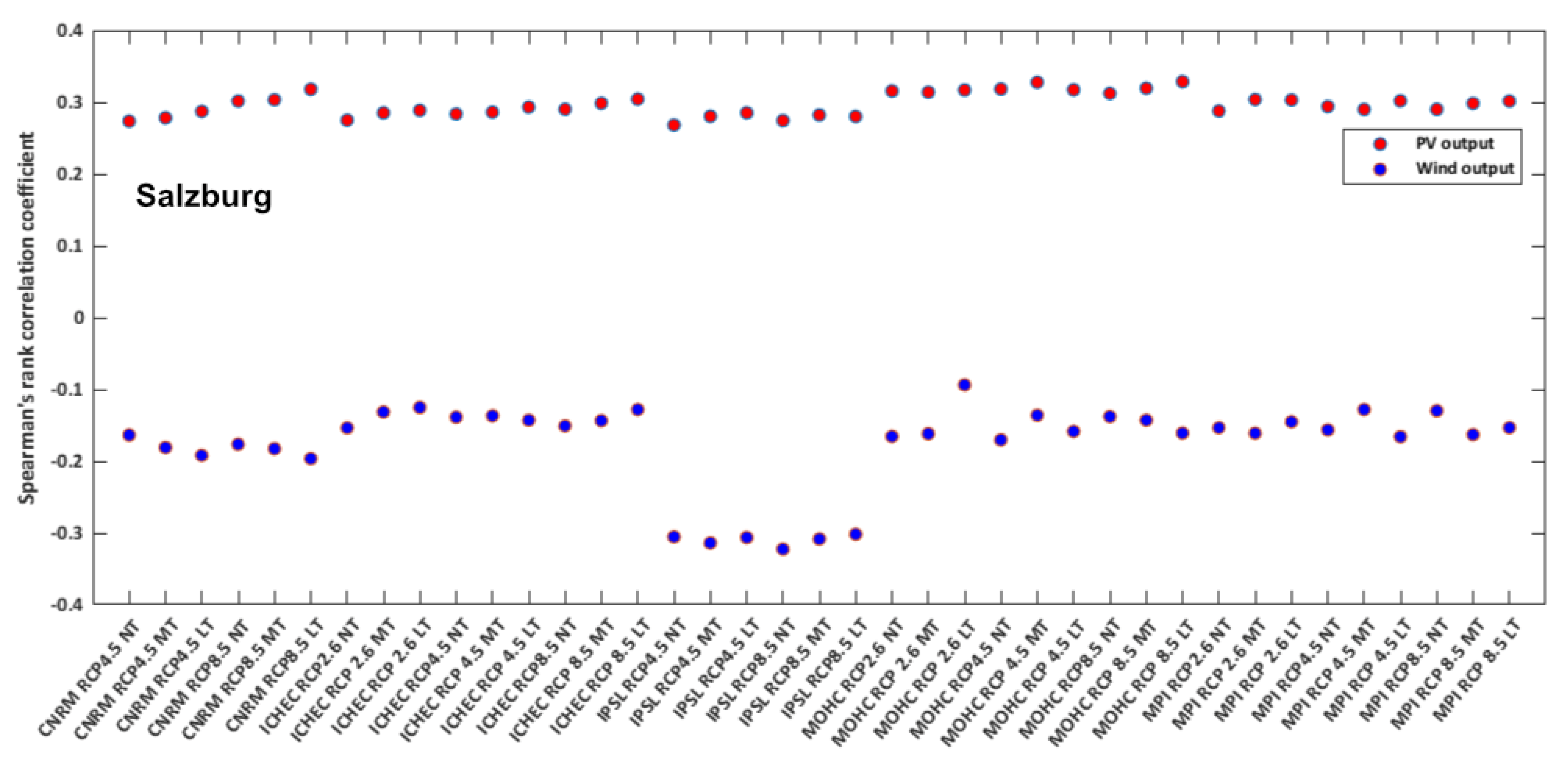
| City | Solar RCP 2.6 | Solar RCP 4.5 | Solar RCP 8.5 | Wind RCP 2.6 | Wind RCP 4.5 | Wind RCP 8.5 |
|---|---|---|---|---|---|---|
| Gothenburg | y = −8.9 × 10−7x + 132 | y = −1.4 × 10−6x + 133 | y = −1.2 × 10−6x + 133 | y = −1.9 × 10−7x + 4.7 | y = −1.1 × 10−7x + 4.6 | y = −2.4 × 10−8x + 4.6 |
| Narvik | y = −1.1 × 10−6x + 109 | y = −8.3 × 10−7x + 110 | y = −7.9 × 10−7x + 110 | y = −2.1 × 10−7x + 5.1 | y = −1.4 × 10−7x + 4.9 | y = −3.1 × 10−7x + 4.9 |
| Antwerp | y = −9.9 × 10−7x + 137 | y = −8.9 × 10−7x + 136 | y = −2.1 × 10−6x + 136 | y = −6.5 × 10−8x + 4.2 | y = −7.2 × 10−8x + 4.2 | y = −3.2 × 10−8x + 4.2 |
| Munich | y = −1.4 × 10−6x + 155 | y = −2.3 × 10−7x + 154 | y = −1.3 × 10−6x + 153 | y = −5.6 × 10−8x + (4.2 | y = −7.1 × 10−8x + 4.3 | y = 7.3 × 10−10x + 4.3 |
| Athens | y = −2.7 × 10−7x + 223 | y = −2.6 × 10−7x + 224 | y = −2.2 × 10−7x + 224 | y = −1.2 × 10−7x + 4.2 | y = 8.1 × 10−9x + 4.2 | y = 2.5 × 10−8x + 4.2 |
| Valencia | y = −1.3 × 10−7x + 213 | y = −6.4 × 10−7x + 217 | y = −6.4 × 10−7x + 216 | y = 1.17 × 10−8x + 3.4 | y = −2.1 × 10−7x + 3.6 | y = −2.9 × 10−7x + 3.6 |
| Salzburg | y = −1.2 × 10−6x + 160 | y = −7.9 × 10−7x + 158 | y = −2.6 × 10−6x + 159 | y = −7.6 × 10−8x + (3.3 | y = −1.2 × 10−7x + 3.4 | y = −1.2 × 10−7x + 3.4 |
| Coefficient of determination (R2) | Solar RCP 2.6 | Solar RCP 4.5 | Solar RCP 8.5 | Wind RCP 2.6 | Wind RCP 4.5 | Wind RCP 8.5 |
| Gothenburg | 0.04 | 0.01 | 0.09 | 0.09 | 0.05 | 0.02 |
| Narvik | 0.01 | 0.04 | 0.04 | 0.09 | 0.07 | 0.3 |
| Antwerp | 0.04 | 0.04 | 0.02 | 0.01 | 0.02 | 0.04 |
| Munich | 0.01 | 0.03 | 0.01 | 0.02 | 0.03 | 0.02 |
| Athens | 0.06 | 0.07 | 0.04 | 0.09 | 0.08 | 0.07 |
| Valencia | 0.08 | 0.03 | 0.03 | 0.24 | 0.21 | 0.36 |
| Salzburg | 0.04 | 0.03 | 0.04 | 0.03 | 0.13 | 0.1 |
| GCM | Gothenburg | Narvik | Munich | Antwerp | Salzburg | Valencia | Athens |
|---|---|---|---|---|---|---|---|
| CNRM45 NT–MT | −0.05% | −0.09% | −0.10% | −0.86% | −0.67% | −0.48% | −0.10% |
| CNRM45 MT–LT | −0.50% | −0.03% | −0.57% | −0.53% | −0.35% | −1.46% | −0.73% |
| CNRM85 NT–MT | −0.74% | −0.55% | −0.42% | −1.69% | −2.05% | −0.95% | −0.03% |
| CNRM85 MT–LT | −1.12% | −1.05% | −1.65% | −0.15% | −1.97% | −0.49% | −0.77% |
| ICHEC26 NT–MT | −0.71% | −0.45% | −0.49% | −0.55% | −1.87% | −0.44% | −0.20% |
| ICHEC26 MT–LT | −0.20% | −0.40% | −1.32% | −1.49% | −0.23% | −0.04% | −0.25% |
| ICHEC45 NT–MT | −1.10% | −1.13% | −0.74% | −0.51% | −1.61% | −1.22% | −0.23% |
| ICHEC45 MT–LT | −1.52% | −1.91% | −1.47% | −1.66% | −0.70% | −0.93% | −0.14% |
| ICHEC85 NT–MT | −1.23% | −1.30% | −0.88% | −1.20% | −0.97% | −0.17% | −0.12% |
| ICHEC85 MT–LT | −0.07% | −1.29% | −1.80% | −1.47% | −1.78% | −0.31% | −0.17% |
| IPSL45 NT–MT | −0.76% | −0.85% | −1.31% | −0.47% | −0.62% | −0.02% | −0.28% |
| IPSL45 MT–LT | −0.40% | −1.56% | −0.88% | −0.28% | −0.59% | −1.00% | −0.45% |
| IPSL85 NT–MT | −1.72% | −0.47% | −2.13% | −0.08% | −1.95% | −0.23% | −0.41% |
| IPSL85 MT–LT | −1.19% | −1.17% | −2.17% | −0.40% | −0.85% | −0.26% | −0.93% |
| MOHC26 NT–MT | −0.01% | −1.09% | −1.69% | −1.70% | −0.90% | −0.29% | −0.18% |
| MOHC26 MT–LT | −1.07% | −1.31% | −1.50% | −0.40% | −0.31% | −0.02% | −0.03% |
| MOHC45 NT–MT | −0.08% | −0.95% | −1.91% | −1.83% | −1.68% | −0.24% | −0.08% |
| MOHC45 MT–LT | −0.34% | −0.92% | −0.92% | −1.20% | −1.66% | −0.45% | −0.47% |
| MOHC85 NT–MT | −1.82% | −1.03% | −0.48% | −0.59% | −0.08% | −0.37% | −0.38% |
| MOHC85 MT–LT | −0.05% | −1.15% | −1.81% | −2.04% | −2.00% | −0.26% | −0.76% |
| MPI26 NT–MT | −0.49% | −0.44% | −1.97% | −2.29% | −1.36% | −0.25% | −0.29% |
| MPI26 MT–LT | −2.43% | −0.46% | −1.33% | −2.21% | −1.16% | −0.57% | −0.01% |
| MPI45 NT–MT | −0.57% | −1.24% | −0.86% | −0.22% | −0.92% | −0.14% | −0.19% |
| MPI45 MT–LT | −0.47% | −1.36% | −1.41% | −2.63% | −1.01% | −0.21% | −0.11% |
| MPI85 NT–MT | −1.85% | −1.55% | −1.48% | −0.59% | −0.43% | −0.10% | −0.16% |
| MPI85 MT–LT | −0.28% | −1.83% | −1.73% | −1.01% | −1.54% | −0.43% | −0.51% |
| GCM | Gothenburg | Narvik | Munich | Antwerp | Salzburg | Valencia | Athens |
|---|---|---|---|---|---|---|---|
| CNRM45 NT–MT | −2.6% | −3.0% | 4.4% | 1.3% | −3.6% | 10.6% | 2.7% |
| CNRM45 MT–LT | −6.6% | −0.5% | −5.8% | −8.4% | −1.6% | 7.1% | 1.7% |
| CNRM85 NT–MT | 2.3% | 3.8% | −3.3% | −3.6% | −3.3% | −4.1% | 1.6% |
| CNRM85 MT–LT | 1.0% | 11.3% | 1.6% | −0.2% | 4.7% | 15.7% | −4.8% |
| ICHEC26 NT–MT | −12.1% | −6.3% | −1.0% | −5.5% | 7.9% | −0.3% | 5.4% |
| ICHEC26 MT–LT | 11.1% | 6.6% | −3.7% | 4.0% | −2.5% | −6.4% | −4.6% |
| ICHEC45 NT–MT | 4.8% | 5.6% | 4.5% | 7.2% | −3.2% | −13.4% | −9.7% |
| ICHEC45 MT–LT | 11.0% | 12.8% | −3.7% | −5.4% | 4.6% | 9.5% | 12.4% |
| ICHEC85 NT–MT | 0.1% | −4.1% | 5.6% | 2.8% | −4.1% | 12.1% | 2.1% |
| ICHEC85 MT–LT | −0.2% | 5.8% | −2.0% | 2.8% | 13.5% | −7.3% | −0.5% |
| IPSL45 NT–MT | 9.6% | 2.8% | −2.4% | 4.0% | 8.0% | −10.7% | 2.8% |
| IPSL45 MT–LT | 4.3% | 8.0% | 10.5% | 9.2% | 8.4% | 6.0% | 2.8% |
| IPSL85 NT–MT | −13.3% | 4.6% | −6.5% | −5.5% | 8.9% | 1.1% | 7.8% |
| IPSL85 MT–LT | −4.8% | 3.7% | 0.0% | −3.4% | −1.6% | −7.8% | 1.0% |
| MOHC26 NT–MT | 6.6% | 13.2% | 9.5% | 8.6% | 8.6% | 7.1% | −4.6% |
| MOHC26 MT–LT | 7.2% | 5.0% | 0.1% | 4.9% | 6.4% | −13.1% | 2.9% |
| MOHC45 NT–MT | −15.0% | −7.4% | 1.3% | −7.4% | −2.5% | 22.3% | 0.6% |
| MOHC45 MT–LT | 19.8% | 11.3% | 4.1% | 11.3% | 6.0% | −12.4% | 1.2% |
| MOHC85 NT–MT | 8.1% | 20.4% | 11.2% | 10.8% | 1.4% | 15.4% | −5.2% |
| MOHC85 MT–LT | −1.1% | −2.9% | −5.5% | −7.7% | −4.1% | 15.6% | −2.0% |
| MPI26 NT–MT | 4.6% | −3.7% | 7.1% | 12.1% | 6.0% | −12.0% | 10.3% |
| MPI26 MT–LT | −6.8% | 4.9% | −4.1% | −9.7% | 0.0% | 6.3% | −4.5% |
| MPI45 NT–MT | 3.3% | 18.9% | 9.8% | 9.0% | 3.3% | −1.4% | 1.4% |
| MPI45 MT–LT | −9.9% | −2.6% | −11.6% | −14.9% | −8.1% | 9.3% | −2.8% |
| MPI85 NT–MT | 12.1% | 2.3% | −9.8% | −6.7% | −4.5% | −22.4% | −10.5% |
| MPI85 MT–LT | −12.5% | 0.8% | −6.4% | −10.9% | −0.2% | 10.1% | 8.3% |
Publisher’s Note: MDPI stays neutral with regard to jurisdictional claims in published maps and institutional affiliations. |
© 2022 by the authors. Licensee MDPI, Basel, Switzerland. This article is an open access article distributed under the terms and conditions of the Creative Commons Attribution (CC BY) license (https://creativecommons.org/licenses/by/4.0/).
Share and Cite
Yang, Y.; Javanroodi, K.; Nik, V.M. Climate Change and Renewable Energy Generation in Europe—Long-Term Impact Assessment on Solar and Wind Energy Using High-Resolution Future Climate Data and Considering Climate Uncertainties. Energies 2022, 15, 302. https://doi.org/10.3390/en15010302
Yang Y, Javanroodi K, Nik VM. Climate Change and Renewable Energy Generation in Europe—Long-Term Impact Assessment on Solar and Wind Energy Using High-Resolution Future Climate Data and Considering Climate Uncertainties. Energies. 2022; 15(1):302. https://doi.org/10.3390/en15010302
Chicago/Turabian StyleYang, Yuchen, Kavan Javanroodi, and Vahid M. Nik. 2022. "Climate Change and Renewable Energy Generation in Europe—Long-Term Impact Assessment on Solar and Wind Energy Using High-Resolution Future Climate Data and Considering Climate Uncertainties" Energies 15, no. 1: 302. https://doi.org/10.3390/en15010302
APA StyleYang, Y., Javanroodi, K., & Nik, V. M. (2022). Climate Change and Renewable Energy Generation in Europe—Long-Term Impact Assessment on Solar and Wind Energy Using High-Resolution Future Climate Data and Considering Climate Uncertainties. Energies, 15(1), 302. https://doi.org/10.3390/en15010302








